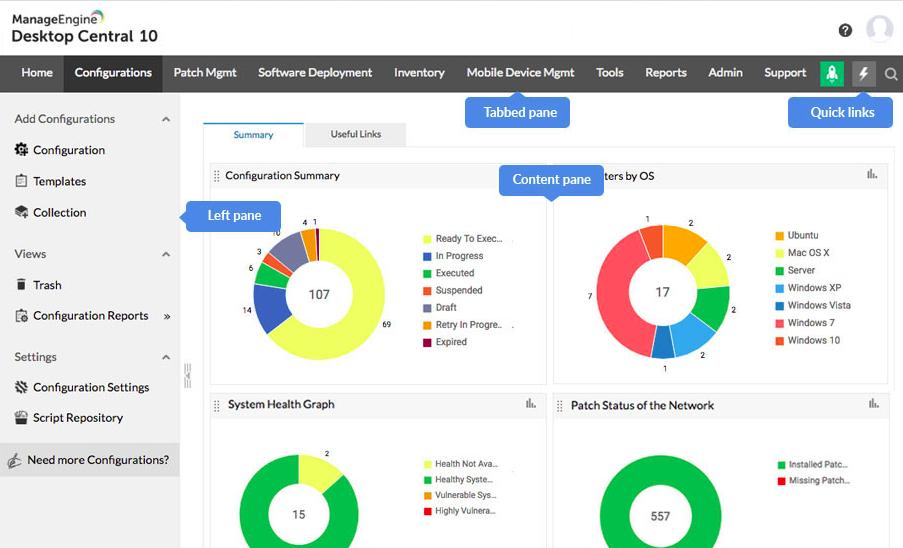Kicking off with endpoint management software, organizations today face an overwhelming array of devices connecting to their networks. This software serves as a crucial tool for managing, securing, and optimizing these endpoints, ensuring that all devices function smoothly and securely within the IT infrastructure. As businesses increasingly rely on remote work and mobile devices, the importance of effective endpoint management cannot be overstated.
This software not only helps in tracking and maintaining devices but also provides essential security measures to protect sensitive data from potential breaches. With the rise of cyber threats, having a robust endpoint management solution is vital for any company aiming to safeguard its digital assets while enhancing overall operational efficiency.
In the rapidly evolving landscape of the 21st century, digital transformation has emerged as a defining factor for organizations across various sectors. This phenomenon is not merely about adopting new technologies but reshaping the entire business model to harness the power of digital innovations. From startups to multinational corporations, the shift towards a digital-first approach has become an imperative rather than an option.
In this article, we will explore the multifaceted aspects of digital transformation, its significance, and the strategies businesses can employ to navigate this new normal effectively.
Understanding Digital Transformation
Digital transformation refers to the integration of digital technology into all areas of a business, fundamentally changing how it operates and delivers value to its customers. It encompasses a cultural shift that requires organizations to challenge the status quo, experiment, and become more comfortable with failure as they innovate. The four major components of digital transformation include technology, processes, culture, and customer experience.
Technology
At the heart of digital transformation lies technology. The proliferation of advanced technologies such as artificial intelligence (AI), machine learning, cloud computing, and the Internet of Things (IoT) has enabled businesses to streamline their operations and enhance their offerings. For instance, AI can analyze vast amounts of data to provide insights that drive decision-making, while cloud computing allows for greater collaboration and flexibility in accessing applications and data.
Processes
The integration of technology necessitates a reevaluation of existing processes. Organizations must rethink their workflows to leverage digital tools effectively. This can involve automating mundane tasks, optimizing supply chains, or implementing agile methodologies that encourage faster delivery and adaptation to changes in the market. It is essential for businesses to become more agile and responsive to customer needs, which requires a continuous improvement mindset.
Culture
Perhaps the most challenging aspect of digital transformation is cultivating a culture that embraces change. Employees must be equipped with the right skills and encouraged to adopt a digital-first mindset. Organizations can foster this culture by investing in training programs, encouraging collaboration, and promoting innovation. Leadership plays a crucial role in this process, as leaders must not only endorse digital initiatives but also act as champions of change within the organization.
Customer Experience
Ultimately, the goal of digital transformation is to enhance customer experience. In today’s digital age, consumers expect personalized and seamless interactions with brands. Businesses must leverage data analytics to understand customer preferences and behaviors, allowing them to tailor their offerings accordingly. This might involve refining the customer journey, optimizing digital touchpoints, and providing responsive customer service through various channels, including social media and chatbots.
The Importance of Digital Transformation
The significance of digital transformation cannot be overstated. Organizations that fail to adapt risk falling behind their competitors and losing relevance in their respective industries. A study by McKinsey & Company revealed that companies that invest in digital transformation are 2.5 times more likely to experience revenue growth than those that do not.
The benefits of embracing digital transformation include increased operational efficiency, enhanced customer satisfaction, and improved profitability.
Strategies for Successful Digital Transformation
Navigating the complexities of digital transformation requires a strategic approach. Here are some key strategies that businesses can implement to ensure a successful transition:
1. Define a Clear Vision
Before embarking on a digital transformation journey, organizations must define a clear vision and objectives. This vision should align with the overall business strategy and be communicated effectively across all levels of the organization. Engaging stakeholders in this process can foster a sense of ownership and commitment to the transformation effort.
2. Invest in Technology
Investing in the right technology is crucial for enabling digital transformation. Organizations should assess their current technology stack and identify areas for improvement. This may involve upgrading existing systems, adopting new tools, or partnering with technology vendors to leverage cutting-edge solutions. It is also important to ensure that the chosen technologies integrate seamlessly with existing processes.
3. Foster a Culture of Innovation
Encouraging a culture of innovation is essential for driving digital transformation. Organizations should create an environment where employees feel safe to experiment and propose new ideas. This can be achieved through initiatives such as hackathons, innovation labs, and cross-functional teams that focus on developing and testing new concepts. Recognizing and rewarding innovative efforts can further motivate employees to contribute to the transformation journey.
4. Prioritize Data-Driven Decision Making
In the digital age, data is a valuable asset. Organizations must prioritize data-driven decision-making by implementing analytics tools that provide insights into customer behavior, market trends, and operational performance. By leveraging data, businesses can make informed decisions that align with their digital transformation goals and enhance overall performance.
5. Ensure Continuous Learning
Digital transformation is not a one-time initiative but a continuous journey. Organizations should cultivate a culture of lifelong learning, where employees are encouraged to upskill and stay abreast of industry trends and technological advancements. Offering training programs, workshops, and access to online resources can help employees adapt to the changing landscape.

Challenges to Overcome
While the benefits of digital transformation are significant, organizations may encounter various challenges during their journey. Resistance to change, lack of technical expertise, and insufficient funding are common hurdles that can impede progress. To address these challenges, organizations should foster open communication, involve employees in the transformation process, and allocate sufficient resources to support their initiatives.
Conclusion
In conclusion, digital transformation represents a paradigm shift that organizations must embrace to thrive in the modern business landscape. By understanding its components, recognizing its importance, and implementing strategic approaches, businesses can successfully navigate the complexities of digital transformation. As technology continues to evolve, organizations that prioritize digital initiatives will be better positioned to meet customer demands, drive innovation, and achieve sustainable growth in the long run.
The new normal is here, and it is digital—those who adapt will undoubtedly lead the way.
Question & Answer Hub
What is endpoint management software?
Endpoint management software is a tool designed to monitor, manage, and secure devices that connect to a company’s network.
Why is endpoint management important?
It is crucial for maintaining security, compliance, and operational efficiency across all devices within an organization.

Can endpoint management software help with compliance?
Yes, it can assist in ensuring that devices comply with industry regulations and organizational policies.

What types of devices can endpoint management software manage?
This software can manage laptops, desktops, smartphones, tablets, and other IoT devices.
Is endpoint management software suitable for small businesses?
Absolutely, it can benefit businesses of all sizes by providing essential management and security features.




























